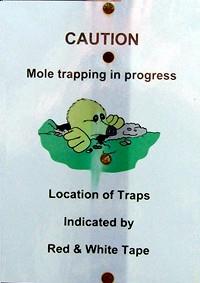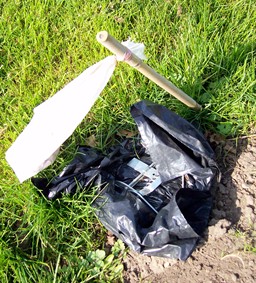|
Hunting down Mr Mole
If you go down to the cemetery today
you had better tread carefully because metal traps have been placed at
strategic points to catch Mr Mole who has been condemned as public enemy
No 1 and the hunt in now on to seek out and destroy.
It would therefore seem apparent that few of our town councillors appear
to be familiar with one of the gems of English literature, The Wind in the
Willows, which endeared the mole to generations of children and made the
very thought of killing one abhorrent. The story which reflects a pastoral
vision of England through the lives of anthropomorphised animals
inhabiting the countryside and particularly the riverbank is a simple one
with villains and heroes, told by Kenneth Grahame (1859-1932) as a bedtime
story for his son and published in 1908 to find a place in the hearts of
the nation, never having been out of print since.
Anyone who has read the book could never countenance the extermination of
those animals which inhabit its pages, the mole being among the most
engaging and lovable, loyal, trusting and always optimistic, yet were he
alive today he would find Bourne Town Council an unsympathetic enemy bent
on the annihilation of his species and in doing so will incur the wrath of
generations of people of all ages who have found such delight in these
pages.
In the 100 years that have passed since The Wind in the Willows first
appeared, the mole has become the dreaded enemy of all those who
administer grassy areas, whether a lawn in the back garden, the meadowland
of a public park or, as in this case, the neat and tidy landscape of a
town cemetery, because these animals live underground and regularly
excavate new burrows, leaving piles of earth in their wake, which does not
please those in charge of these open spaces which are rendered untidy in
the process.
Moles are now making their presence felt at the cemetery in South Road and
their underground activities have even been blamed for destroying graves
and headstones (a likely story). The town council is suitably outraged and
has purchased traps to kill them off. This does seem to be a desperate
measure because no one wishes to see our little furry friends removed with
such finality and perhaps councillors are making a mountain out of a
molehill because there are plenty of alternative methods available today,
particularly electronic and sonic devices which will do the job equally
effectively without the need to slaughter our wildlife. It is not as if
they are particularly widespread because the mole population has been
estimated at a mere four per acre and so the problem in the cemetery
cannot be as acute as has been suggested.
Killing them off may also be a bad idea because scientists suggest that no
matter what is used, gas, poison or traps, the mole is here to stay and
therefore battery or solar powered electronic repellents which are
guaranteed to work are a far more advisable solution and can be obtained
for as little as £20 each (including delivery). Half a dozen of them would
therefore be a comparatively cheap alternative to a killing spree that may
not be successful anyway.
Animal lovers everywhere will deplore this course of action and lament the
fact that the town council does not have access to wise old Badger who
would advise strongly against such drastic measures. Killing a living
creature is demeaning and expediency is not always the best solution
especially when it infringes morality. Those councillors who have endorsed
this action should go away and read The Wind in the Willows because the
appeal of this book is far too emotive to be ignored by even to most
callous and hard-hearted. Some of them are also governors of the Bourne
Abbey CE and Westfield County primary schools where the preservation of
our flora and fauna is high on the curriculum and next time they find
themselves in the classroom, perhaps they will
explain to the children their decision to murder Mr Mole.
Note: Reproduced from entries in The Bourne Diary
for
Saturday 1st November 2008 and Saturday 28th March 2009.
Return to The town cemetery

Go to:
Main Index Villages
Index
|

